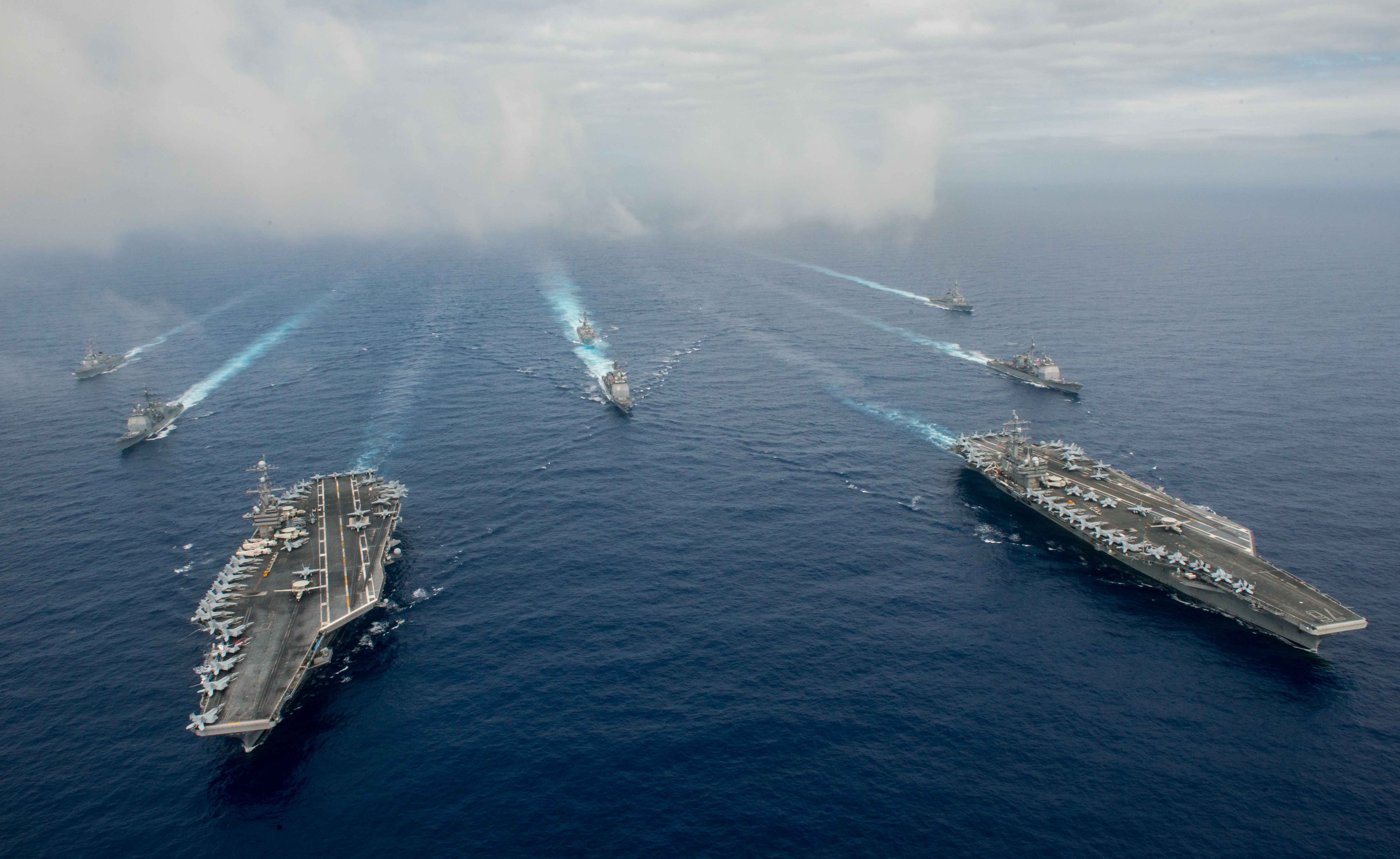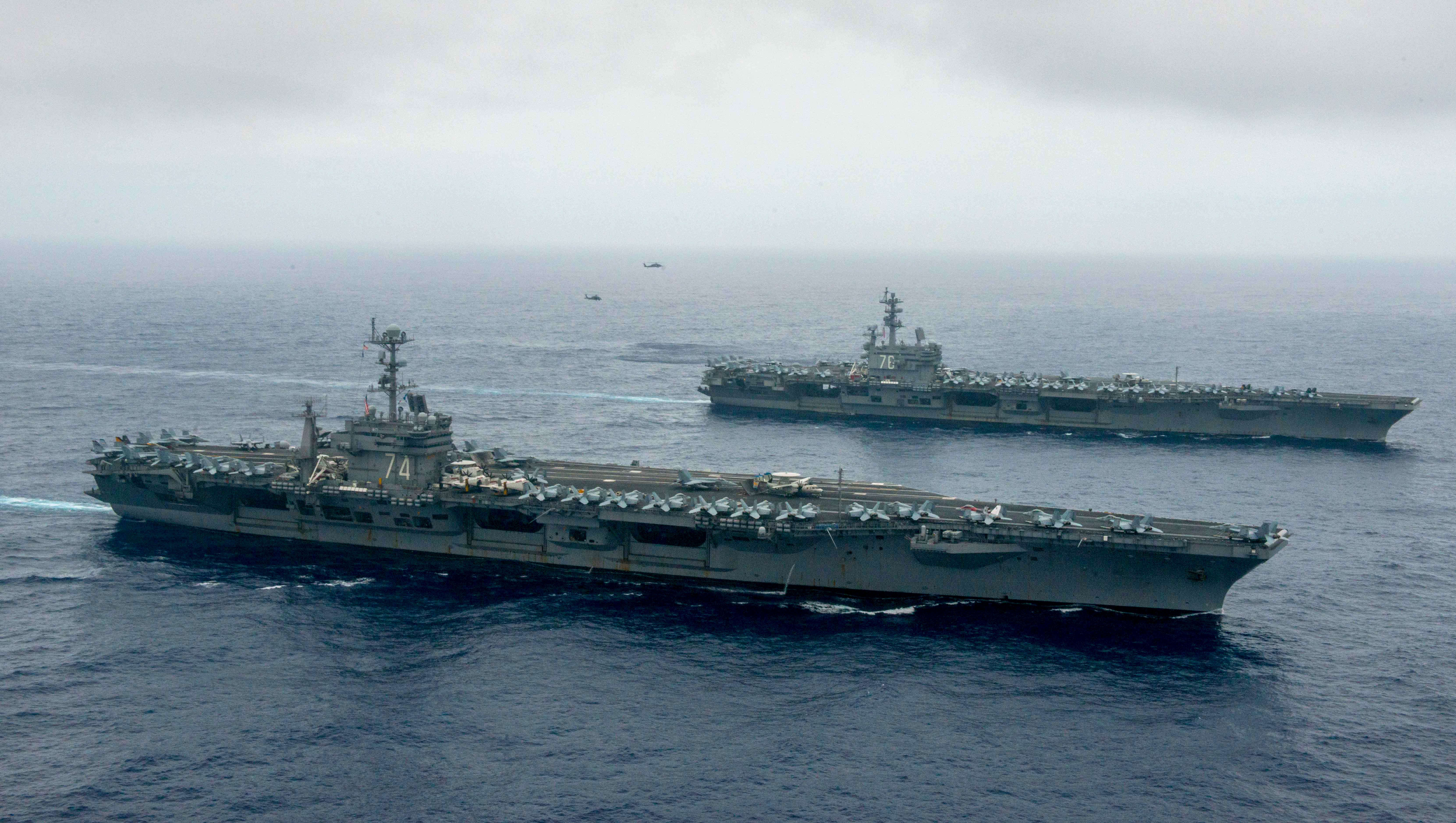
This post has been updated to include comments from Chief of Naval Operations Adm. John Richardson.
The aircraft carriers USS John C. Stennis (CVN-74) and USS Ronald Reagan (CVN-76) began dual-carrier flight operations in the Philippine Sea over the weekend, for the first time in about two years.
The ships and aircraft from both carrier strike groups began coordinated operations in international waters on June 18, “demonstrating the United States’ unique capability to operate multiple carrier strike groups in close proximity,” according to a Navy news release. The operations included air defense drills, sea surveillance, replenishments at sea, long-range strikes and more,
“This is a great opportunity for us to train in a high end scenario.” Rear Adm. John Alexander, commander of Battle Force 7th Fleet and commander of Carrier Strike Group 5/Ronald Reagan CSG, said in the release.
“We must take advantage of these opportunities to practice warfighting techniques that are required to prevail in modern naval operations.”
Ronald Reagan had been laid up in selective restricted availability maintenance period since December. The forward-deployed carrier went back out to sea on June 4 for its summer patrol, allowing for the dual-carrier training opportunity before Stennis heads to Hawaii for the Rim of the Pacific (RIMPAC) 2016 exercise.
“Rear Adm. Alexander and I first flew together as a crew in an A-6 carrier-based aircraft in July 1988. Today, we continue that long history as our two carrier strike groups maneuver together in the Philippine Sea,” Rear Adm. Marcus Hitchcock, commander of CSG 3/Stennis CSG, said in the Navy news release.
“No other Navy can concentrate this much combat power on one sea or synchronize the activities of over 12,000 sailors, 140 aircraft, six combatants and two carriers. It was truly impressive, and it is an important operational capability.”
Chief of Naval Operations Adm. John Richardson addressed the dual-carrier operations today at a Center for a New American Security conference in Washington, saying “we don’t get to do two-carrier operations very often … so it’s a terrific opportunity for us to do some high-end warfighting and training.”
He said his Design for Maintaining Maritime Superiority calls for innovation in blue-water operations, and because the Navy’s blue-water capabilities are being contested now in a way they haven’t in decades, “we have to make sure that we don’t snap back to purely the muscle memory we did before, because there is so much new to that challenge right now. So if you think about what’s happened in space, what’s happened in the information domain, what has happened in terms of unmanned, autonomy, those sorts of things provide us new dimensions, new levels of complexity to this challenge.”
Richardson said he has teams studying how to operate at sea in today’s environment, and “they are really being creative in terms of how they approach that challenge, coming up with new ways to operate and very very clever in terms of the way they stitch together (Navy assets).” The ability to test these ideas with two carrier strike groups operating together “is just another chance to take that up to the next level.”
It has been about two years since the Navy saw dual-carrier operations in the Western Pacific despite a shift in focus to the Asia/Pacific region. USS George Washington (CVN-73) had been the forward-deployed carrier operating out of Yokosuka, Japan, until May 2015, when the carrier headed to Norfolk, Va., for its mid-life refueling and complex overhaul, set to begin next year. After a three-carrier swap, Ronald Reagan moved to Japan in October 2015 but went into maintenance just two months later.

Carrier operations had been somewhat hampered since sequestration and subsequent budget caps cut operations and maintenance funding and threatened to turn George Washington’s midlife refueling into a defueling and decommissioning. In the midst of the budget churn, USS Dwight D. Eisenhower (CVN-69) deployed back-to-back and paid the price during a maintenance period after the second deployment, which dragged out two years instead of the planned 14 months.
As recently as last fall, half the carrier fleet was tied up in maintenance, leaving only five carriers to train and deploy and leading to a carrier gap in the Middle East.
The carrier fleet has rebounded since then, with six carriers at sea, four of them deployed overseas and two operating locally.
Aside from John C. Stennis and Ronald Reagan in the Philippine Sea, Eisenhower and USS Harry S. Truman (CVN-75) are operating in the Mediterranean Sea. They are not, however, conducting dual-carrier operations, with the Truman CSG conducting strikes against ISIS and the Ike CSG conducting Great Green Fleet operations.
Still, U.S. 6th Fleet commander Vice Adm. James Foggo told reporters last week that “we actually have 840,000 tons of U.S. gray-hull warships operating in the European theater right now. That is huge, I don’t think we’ve seen anything like that since Operation Iraqi Freedom in 2003.”
At the CNAS conference, Richardson said of the heavy carrier presence around the world today that “I think both (in the Pacific) and in the Mediterranean, it’s a signal to everybody in the region that we’re committed, we’re going to be there for our allies to reassure them. And for anybody who wants to destabilize that region, we hope that there’s a deterrent message there as well.”





